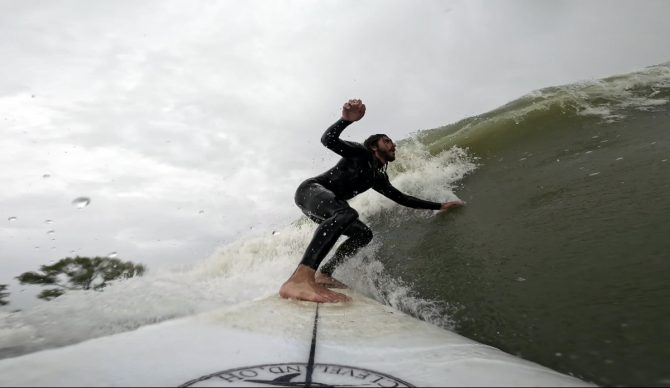
Ohio local Joseph Gerin scored in his home state. And there might be more on the way.
Epic tales are circulating of Gulf Coast surfers who capitalized on the powerful waves generated by Category 4 Hurricane Helene – sand-pounding barrels along the shores of Alabama and Florida. While the south was sadly taking a destructive beating in places like Western North Carolina, Ohio surfers nearly 800 miles to the north were eagerly awaiting their chance to get in the water.
After Helene crashed into Florida’s Big Bend and tore through Appalachia, the storm’s remnants pushed northward, churning the usually placid waters of Cleveland, Ohio. On the shores of Lake Erie, surfers were ready and waiting.
“We have buoys on the Great Lakes and one was reading at six-and-a-half to seven feet at six seconds,” said Cleveland surfer Joseph Gerin. “All that wind on the lake was (coming from a) direction that had the right amount of fetch.”
Gerin, 28, who first learned to surf when he was 16 while on vacation in Virginia Beach, had been tracking the path of Helene about a week before its arrival. When the buoys confirmed what the forecasts had predicted, he struck out west of town to check a spot he thought might be working.
“Cleveland got waves, but I went about 30 miles west for some bigger waves with more fetch,” said Gerin. “The specific spot I went to on that kind of wind really picks up swell. My friend said it was good, but I got out there late (because of work). It was just me and a handful of other guys who were aware of some of the lesser-known spots around the lake. I went out but it was completely a washing machine, a blown-out mess. So, instead, I went to a spot right next to downtown Cleveland that had more protection from all the chaos. It was definitely a longboard wave, but it still had some height to it, about chest high maybe. There must have been at least 35 people in the water at one point.”
“The second day cleaned up and that’s where I got pretty good POV (GoPro) footage of some decent lefts that were about chest to head high,” Gerin continued, adding that he didn’t want to argue wave height with ocean surfers. “The crowd was just me and a couple of buddies. It went from 35 people the previous day to just three or four.”
After surfing their brains out for two days, Gerin and the other Ohio surfers were blessed with an unexpected third day of swell on Lake Erie.
“The third day I didn’t expect to go surfing,” said Gerin. “I was trying to edit the videos from the first two days, but my buddy called me up. He was like, ‘Yo, there’s still a wave up here!’ The wind had died, but it was going just enough to keep it rolling. We went and surfed until sunset. It was pretty alright, just a bit smaller, probably about stomach to chest high at that point.”
Despite living on a lake, Gerin says he surfs on average around 50 to 100 days per year in the Cleveland area depending on if the lake freezes over for winter. There’s a surf community that’s been present since the ’60s, but he’s noticed the sport has really started to grow in the area over the past decade. He says that the crowds are relatively thick during the early autumn swells when the air and water are still over 70 degrees Fahrenheit, but once the winter temperatures kick in, the lineups thin out.
“Most of the surfers out there are all friendly to one another,” said Gerin. “Most are beginners or intermediate, but there are some that can really shred.”
But by speaking with Gerin I also learned that lakes are not spared from the inherent localism in ocean surfing.
“There are, unfortunately, a few surfers who think they own the beach when they don’t,” said Gerin. “But it’s not so much localism as it is making sure we have access to our spots. It can get pretty dangerous – the short interval waves breaking over rocks. Most of the coastline is privatized, so if someone gets hurt at one of the few spots that we have available, they could make it illegal for whatever reason. There are already metro park beaches in Cleveland where surfing isn’t allowed during the summer because they have lifeguards.”
And after a satisfying run of swell from Helene, Gerin is already eyeing more surf in the forecast.
“There’s a possibility there might be some more waves next week, but it’s too far to look ahead,” said Gerin. “We have to check the weather every other hour because it can change instantly.”

